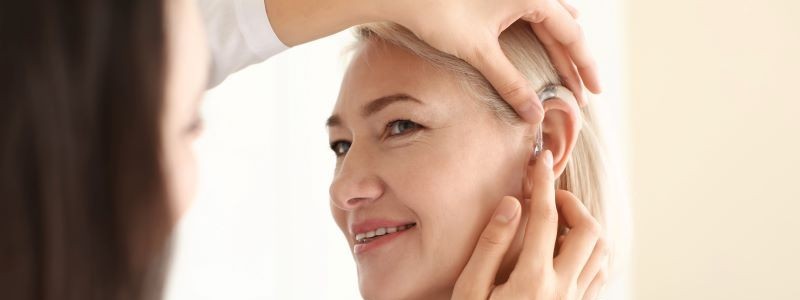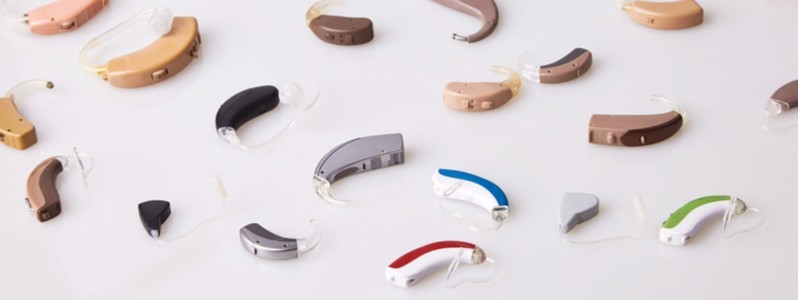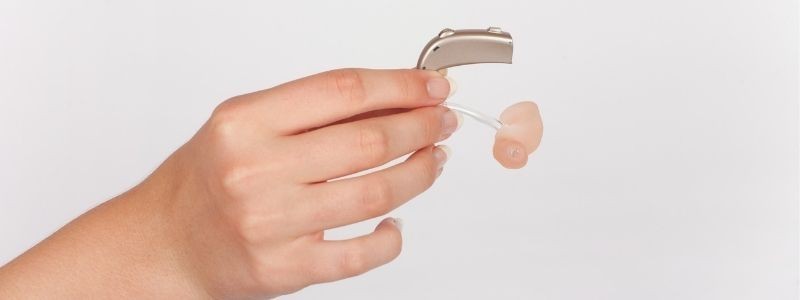
Head of Online Medical Content

Audiology Expert at Hearing Aid UK

Telecoil Hearing Aids (T coil)
What are telecoil hearing aids and why are they important?
Overview | Before telecoils | What is a loop system? | The technology | The benefits | Do I need them? | Summary
Last Hearing Aid UK Update:
Overview
Telecoil hearing aids, or T-coils, enhance hearing by wirelessly picking up magnetic signals from compatible devices like phones and induction loop systems.
This allows users to directly receive sound, reduces background noise, and improves clarity in public places like theatres and churches, enhancing overall accessibility for the hearing impaired.
In this article, we will discuss what telecoil hearing aids are, their advantages, how they work alongside loop systems, who should be using them, and whether they are a feature you could benefit from.
Before telecoils
Although hearing aids are instrumental in helping people hear better, relying on the device’s built-in microphones is not the best option for every occasion.
The two million people in the UK who wear hearing aids can still face challenges in understanding speech in public places. Let’s take a visit to a church as an example.
A minister’s sermon will likely sound muddled for a hearing aid wearer because a cavernous church will easily reverberate and mix speech sounds with the surrounding background noise, obscuring the minister’s words.
What if I told you that a decades-old, widely available technology could remove all the background noise from the church and make the minister's words immediately clearer? This is what’s possible with a telecoil.
Telecoils in hearing aids - What are they and what do they do?
What are telecoil hearing aids? Telecoil-equipped hearing aids include a small coil that is inside many hearing aids. It is similar to an antenna that picks up magnetic signals and sends them as audio to your hearing aids.
Typically, a hearing aid picks up sound using a microphone and then amplifies it. A telecoil works differently - with this feature, the hearing aid "hears" a magnetic pulse and then amplifies that sound signal.
What is a loop system?
To be able to use your hearing aid’s telecoil feature, you need to enter an area that contains a loop system.
Loop systems are composed of three parts— a microphone, a loop amplifier, and a loop of wire. The loop of wire is positioned around the circumference of the physical space.
The space may be very large, such as a concert venue or a church, or rather small, such as a living room. A loop can even be mounted around a person's head (called a neck loop).
Hearing aid loops and mobile phones
To assist those listening to mobile phones with a hearing aid, people usually prefer accessing Bluetooth technology. However, there are many universal solutions for this out there on the market, which are suitable with your hearing aids set to the 'T' or 'Loop' program setting.
Telecoil Hearing Aid Technology
Telecoils, hearing aids and loop systems
How do telecoils and loop systems work together?
Here is how the hearing loop works in conjunction with a telecoil to send sound directly into your ear:
- An audio signal is identified from a sound source, such as your TV, stereo, or public PA system, via a microphone.
- This signal is amplified and travels along the loop of wire, which goes around the entire area.
- As the signals travel through the loop of wire, a magnetic field is produced in the area that mimics the original sound signal.
- A telecoil fitted inside a hearing aid converts this magnetic field into the sound you can hear. When you toggle your hearing aid from the microphone to its telecoil feature, it connects a small wire coil (the telecoil) to the input of the hearing aid amplifier.
This tiny wire coil is attuned to nearby magnetic fields, such as the one generated by the loop system.
- The magnetic field produced in the room loop triggers the same electrical signal in the telecoil.
- The hearing aid amplifier then boosts this signal, letting you experience an accurate reproduction of the sound signal in your ears.
Why should you use the hearing aid telecoil mode? What are the benefits of them?
There are several benefits to using the telecoil feature in a hearing aid. For example, they provide better speech comprehension.
Hearing aid microphones have a limited range, but the telecoil offers greater audibility for people with hearing aids when listening to speech, sometimes even better than for people with normal hearing!
It does this by cutting out unwanted background noise.
Telecoils are more inconspicuous. When a loop system is in place, hearing aid wearers don’t have to risk an embarrassing situation by asking for an extra device, which could mark them out as someone saddled with hearing loss.
Plus, there is no need to use bulky, expensive receivers when the telecoil is already within the hearing aid itself.
Telecoils are also more accessible. Anyone with a compatible hearing aid can use the system, and it will serve everyone who can stand inside the loop.
Do I need telecoil hearing aids?
In reality, however, there are some instances where telecoils might not be the best option. For instance, they are not optimised for music and are non-portable. Telecoils are designed for speech signals, so music may sound distorted as a result.
This is based on the fact that music is often made up of higher frequencies than the bandwidth of the telecoil can manage.
Using telecoils within a venue requires a fixed loop to be mounted in the space. The loop cannot be transported easily to other locations, and the power of the sound signal is limited to the boundaries of the loop itself.
For example, if a loop is installed for a TV in the living room, the signal strength decreases significantly when the user leaves the living room.

Telecoil for Hearing Aids
A widely available technology
A greater scope of sound at your fingertips
Ever since the Equality Act was passed in 2010, those who have hearing loss are classed as having a disability and are therefore protected by law against discrimination.
This means that businesses and other organisations must provide hearing loop systems to maintain accessibility for all.
A telecoil hearing aid means you will benefit from a greater scope of sound wherever you are, and you don't miss out on the important things in life, like conferences and live gigs. Hearing loops are therefore common in public spaces across the UK, such as:
- Churches
- Concert halls
- Universities
- Airports
- Museums (for guided tours)
How do I find hearing loop systems near me?
If you’re unsure whether a particular venue provides hearing loop services, just look for the loop logo (example below). You can also locate places with loop systems via Google Maps or use an app to indicate where loop systems are in place, such as LoopFinder.
![]()
Do all hearing aids come with Telecoil technology?
No, not all hearing aids have telecoils, but the number is increasing. Broadly speaking, the smaller the unit, the less likely it is to contain a telecoil. This is because the telecoil is usually too large to fit into the smallest devices.
Telecoils are most likely found in two styles of hearing aids: In-the-Ear (ITE) and Behind-the-Ear (BTE). As a rule of thumb, if the hearing aid uses a size 10 battery, it won't include a telecoil.
Which hearing aids come with a Telecoil option?
Some hearing aid models will indicate the presence of a hearing loop in the name by including the letter T. See the table below for some examples (NOTE: this list is not comprehensive; if a T-coil is a feature you are interested in, you can ask one of our audiologists for more options.)
How do I turn on the telecoil in my hearing aids?
Most hearing aids feature a switch that lets you choose between receiving signals from the hearing aid microphone or a loop system. This is known as a "T switch." When you activate the T-setting, the microphone is turned off, so only the signals from the loop system can be heard.
It can be beneficial to receive signals from both the telecoil and the microphone, such as when you want to hear the TV while also hearing surrounding sounds, like your spouse's voice.
To accommodate this, many hearing aids offer an "MT" setting, allowing both the microphone and the telecoil to be active simultaneously.
Hearing aid wearers who want to make use of telecoil technology should talk to a local audiologist. This is because telecoils often need to be activated before they can be used. They can then be easily toggled to enable dramatically improved hearing in a range of public venues.
Hearing aids without a telecoil
You can, in some cases, still access the wireless sound from a hearing aid loop system - you just have to use an additional device, such as a streamer. Please be aware that this would only work if you have a hearing aid with Bluetooth capability.
If you're unsure whether you need a telecoil, consult your hearing care provider to discuss its advantages and disadvantages.
Summary
By tapping into induction loop systems and electromagnetic signals, hearing aids with telecoils can enhance sound quality, reduce background noise, and promote inclusivity in various social and public settings.
With continued advancements in technology, telecoil-enabled hearing aids are empowering those with hearing loss to fully engage with the world around them, improving their overall quality of life.
Why Choose Us?
- FREE Hearing Tests
- Best Hearing Aids and Prices
- FREE Aftercare for Life
- FREE Home Visits
- 200+ Local Audiologists
- 60 Day Money Back Guarantee
Want to know more about hearing aids with telecoil?
Hearing aids with telecoil technology enhance sound quality by directly receiving audio signals from compatible devices like telephones and public sound systems.
This feature reduces background noise, improves speech clarity, and is particularly beneficial in public venues, theatres, and places of worship, providing a better listening experience for wearers.
Call one of our audiologists free on 0800 567 7621 to find out more about telecoil hearing aids, what's available on the market, and whether they can support you and your hearing.
Other articles on hearing aid advice you might like...
 The Best Hearing Aid Providers According to Which?
The Best Hearing Aid Providers According to Which?  Hearing Aids with Directional Microphones
Hearing Aids with Directional Microphones Our specialist service includes:
Do not spend hundreds of pounds without getting a second opinion from us.
Please call us on 0800 567 7621
 Not only are the prices great, but the service is fantastic! Many thanks to your team.
Not only are the prices great, but the service is fantastic! Many thanks to your team.What's included in our hearing aid prices?
Common FAQs about hearing aids and hearing loss
In general, any audiologist will always recommend to you the hearing aid model that best suits your needs. Here is a useful checklist to make sure that is the case.
- Audiologist's level of knowledge: The audiologist you have seen will hopefully have a wide knowledge of all available hearing aids; however, some will only be familiar with a small number of brands and, therefore, may not really be in a position to know which model is the best for you. It is OK to challenge their recommendation and ask them to justify why this particular brand is the one for you.
- Do research: Read about the hearing aid that was recommended. Does it seem like it will suit your lifestyle? Does it have more or fewer features than you need?
- Be aware of sales targets: Many high street retailers have specific tie-ins to a particular manufacturer/brand. The hearing aid they have suggested may still be the correct one for you, but do your research so that you know why they might have recommended it.
If you have significant hearing loss in both ears, you should be wearing two hearing aids. Here are the audiological reasons why:
Localisation: The brain decodes information from both ears and compares and contrasts them. By analysing the minuscule time delays as well as the difference in the loudness of each sound reaching the ears, the person is able to accurately locate a sound source.
Simply put, if you have better hearing on one side than the other, you can't accurately tell what direction sounds are coming from.
Less amplification is required: A phenomenon known as “binaural summation” means that the hearing aids can be set at a lower and more natural volume setting than if you wore only one hearing aid.
Head shadow effect: High frequencies, the part of your hearing that gives clarity and meaning to speech sounds, cannot bend around your head. Only low frequencies can. Therefore, if someone is talking on your unaided side, you are likely to hear that they are speaking, but be unable to tell what they have said.
Noise reduction: The brain has its own built-in noise reduction, which is only really effective when it is receiving information from both ears. If only one ear is aided, even with the best hearing aid in the world, it will be difficult for you to hear in background noise as your brain is trying to retain all of the sounds (including background noise) rather than filtering them out.
Sound quality: We are designed to hear in stereo. Only hearing from one side sounds a lot less natural to us.
Fancy some further reading on this topic? You can read about why two hearing aids are better than one in our article, hearing aids for Both Ears, here
For most people, the main benefit of a rechargeable hearing aid is simple convenience. We are used to plugging in our phones and other devices overnight for them to charge up. Here are some other pros and cons:
For anybody with poor dexterity or issues with their fingers, having a rechargeable aid makes a huge difference, as normal hearing aid batteries are quite small and some people find them fiddly to change.
One downside is that if you forget to charge your hearing aid, then it is a problem that can't be instantly fixed. For most, a 30-minute charge will get you at least two or three hours of hearing, but if you are the type of person who is likely to forget to plug them in regularly, then you're probably better off with standard batteries.
Rechargeable aids are also a little bit bigger and are only available in Behind-the-Ear models.
Finally, just like with a mobile phone, the amount of charge you get on day one is not going to be the same as you get a few years down the line. Be sure to ask what the policy is with the manufacturer's warranty when it comes to replacing the battery.
For most people, the answer is yes. But it's never that simple.
The majority of hearing problems affect the high frequencies a lot more than the low ones. Therefore, open fitting hearing aids sound a lot more natural and ones that block your ears up can make your own voice sound like you are talking with your head in a bucket. Therefore, in-ear aids tend to be less natural.
However, the true answer is we can't tell until we have had a look in your ears to assess the size of your ear canal, and until we have tested your hearing to see which frequencies are being affected.
People with wider ear canals tend to have more flexibility, also there are open fitting modular CIC hearing aids now that do not block your ears.
There is also the age-old rule to consider, that a hearing aid will not help you if it's sat in the drawer gathering dust. If the only hearing aid you would be happy wearing is one that people can't see, then that's what you should get.
Most people can adapt to any type of hearing aid, as long as they know what to expect. Have an honest conversation with your audiologist as to what your needs are.
Generally speaking, six or more. Unless it's none at all. The number of channels a hearing aid has is often a simplistic way an audiologist will use to explain why one hearing aid is better than another, but channels are complex, and it is really not that straightforward. Here are some reasons why:
Hearing aids amplify sounds of different frequencies by different amounts. Most people have lost more high frequencies than low, and therefore need more amplification in the high frequencies. The range of sounds you hear is split into frequency bands or channels, and the hearing aids are set to provide the right amount of hearing at each frequency level.
Less than six channels, and this cannot be done with much accuracy, so six is the magic number. However, a six-channel aid is typically very basic with few other features and is suitable only for hearing a single speaker in a quiet room. The number of channels is not what you should be looking at; it's more the rest of the technology that comes with them.
As a final note, different manufacturers have different approaches. One method is not necessarily better than any other. For example, some manufacturers have as many as 64 channels in their top aids. Most tend to have between 17 and 20. One manufacturer has no channels at all.
Manufacturer's warranties typically last between 2-5 years, depending on the brand and model, and cover defects in materials and workmanship. This includes repairs for component failures, electronic malfunctions, and manufacturing defects, but excludes damage from misuse, accidents, or normal wear. Most manufacturers also include loss and damage insurance for the first year.
We handle all warranty claims on your behalf, liaising with manufacturers and ensuring you get replacement devices quickly when needed. This comprehensive warranty coverage, combined with our lifetime aftercare, gives you complete peace of mind.
Our hearing tests are completely free, whether at our clinics or in your home. Unlike other providers who charge £30-£100 for home visits, we believe hearing healthcare should be accessible without financial barriers. Our comprehensive assessments include examination by a registered audiologist, audiogram results, and personalised recommendations.
All testing, future adjustments, and ongoing support are included at no extra cost. While NHS tests are also free, typical 6-week waiting periods often lead people to seek immediate private testing. We provide prompt, professional assessments that fit your schedule and budget.
Yes, we offer completely free home visits throughout the UK, and this service is included in our prices with no additional charges. Home visits are particularly valuable for people with mobility issues, busy schedules, or those who simply prefer the comfort and convenience of their own environment.
Our audiologists can conduct full hearing tests, fit hearing aids, and provide ongoing support in your home. This service sets us apart from many providers who either don't offer home visits or charge extra for them.
We can offer prices up to 40% lower than high street retailers because of our business model. As a network of 200+ independent audiologists, we don't have the massive overheads of large retail chains - no expensive high street premises, no sales targets pushing audiologists to sell the most expensive options, and no costly marketing campaigns.
However, we maintain the same buying power as the big chains because we purchase on behalf of our entire nationwide network. This means you get access to the same premium hearing aids with professional service, but at genuinely competitive prices.
We offer a comprehensive 60-day money-back guarantee, which gives you twice the industry standard time to properly assess whether your hearing aids are right for you. This extended period recognises that adjusting to hearing aids takes time, and your brain needs several weeks to adapt to the amplified sounds.
Unlike many providers who offer just 30 days, we believe 60 days gives you the confidence to test your hearing aids in all the situations that matter to you - from quiet conversations at home to busy restaurants and outdoor activities.
Other pages you might find useful
Ask the Experts
6 Morton Lane
Walkwood
Redditch
Worcestershire
B97 5QA
Latest Launch
When we refer to a product as 'Latest Launch', we mean it is the latest to be released on the market.
New
When we refer to a product as 'New', we mean that the product is the newest hearing aid model on the market.
When we refer to a product as 'Superseded', we mean that there is a newer range available which replaces and improves on this product.
Older Model
When we refer to a product as an 'Older Model', we mean that it is has been superseded by at least two more recent hearing aid ranges.

